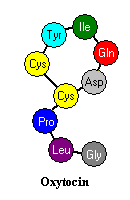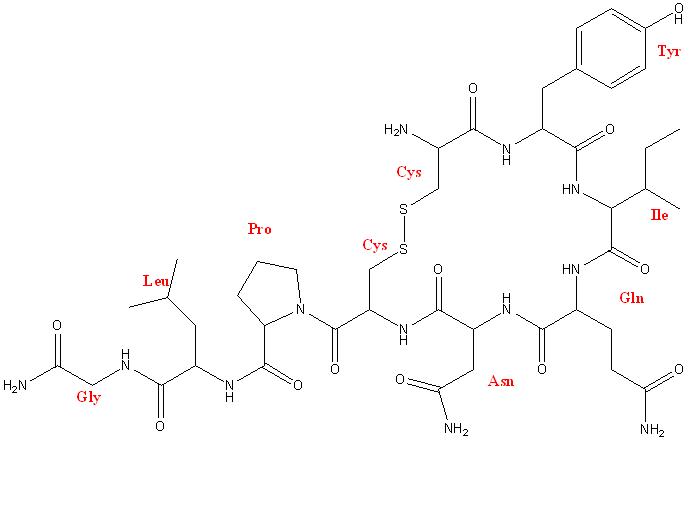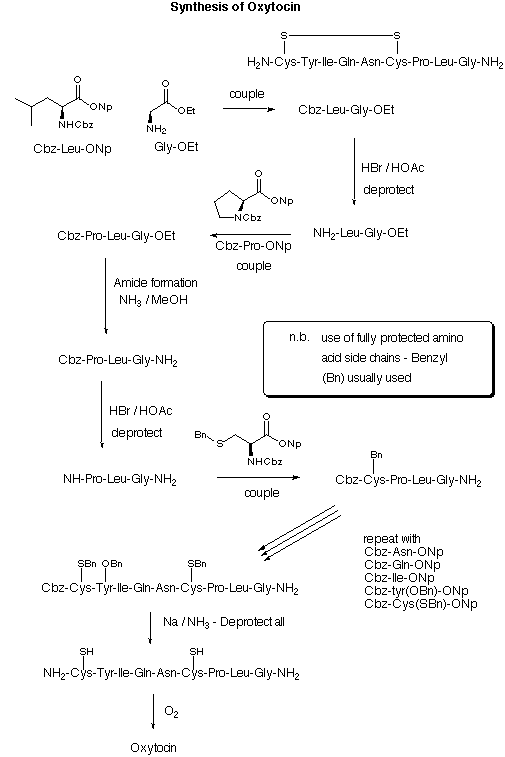It:Oxytocin
| Oxytocin | |
|---|---|
| Synonyms | H-Cys-Tyr-Ile-Gln-Asn-Cys-Pro-Leu-Gly-NH2(Disulfide bond) |
| CAS No. | 50-56-6 |
| Molecular formula | C43H66N12O12S2 |
| Molecular Weight | 1007.19 g/mol |
| Half Life | 3 mins |
| Smiles | CCC(C)C1NC(=O)C(Cc2ccc(O)cc2)NC(=O)C(N)CSSCC(NC(=O)C(CC(=O)N)NC(=O)C(CCC(=O )N)NC1=O)C(=O)N1CCCC1C(=O)NC(CC(C)C)C(=O)NCC(=O)N |
| MSDS | |
Introduction
Oxytocin is a hormone found in mammals that also acts as a neurotransmitter in the brain. In females, it is released to facilitate birth after distention of the cervix and vagina during labour as well as after stimulation of the nipples during breastfeeding. In both sexes it is released during orgasm. Oxytocin in the brain is also involved in social recognition and bonding as well as the formation of trust between people.
Discovery of oxytocin
Oxytocin was discovered, isolated and synthesised by Vincent du Vigneaud in 1953 along with the antideuretic hormone vasopressin. He was presented with the Nobel Prize in Chemistry in 1955.
Structure of oxytocin
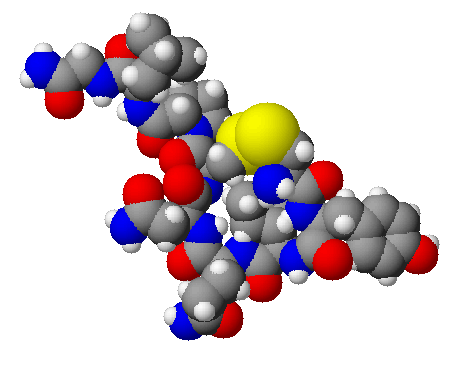
Oxytocin is a peptide with nine amino acids in the following sequence: cysteine - tyrosine - isoleucine - glutamine - asparagine - cysteine - proline - leucine - glycine with a disulphide bridge forming between the two cysteine residues.
Vasopressin has a very similar structure to oxytocin, differing by only two amino acids. The two hormones are the only ones released by the human posterior pituitary gland that do not act locally.
Synthesis, Storage and Release of Oxytocin
Oxytocin is made in magnocellular neurosecretory cells of the hypothalamus and by some neurons that project to other parts of the brain and spinal cord. It is then bound to neurophysin, a large peptide fragment acting as a carrier protein in the pituitary gland and stored in large vesicles before being released from the posterior lobe of the pituitary gland into the bloodstream.
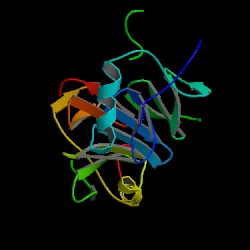
When oxytocin cells in the hypothalamus generate action potentials down the axons to the nerve endings in the pituitary which contains the oxytocin vesicles, the depolarisation of the nerve endings causes secretion of oxytocin by exocytosis within the brain and a few other tissues including the ovaries and testes. Stress can inhibit the release of oxytocin. The production and release of oxytocin is influenced by sex steroid hormones, for example, during birth, the release of oxytocin is due to decreasing concentrations of progesterone and increasing concentrations of oestrogen.
Functions of Oxytocin
Peripheral (hormonal) actions
- Stimulation of milk ejection
Oxytocin acts in the mammary glands in lactating mothers. Milk is initially secreted into small sacs within the mammary gland called alveoli. Sucking of the nipples by infants stimulates the hypothalamus and causes the neurons to fire impulses in short bursts, resulting in the secretion of oxytocin by the posterior pituitary gland. Oxytocin stimulates the contraction of myoepithelial (smooth muscle) cells which surround the mammary alveoli. The contractions lead to milk ejection for consumption.
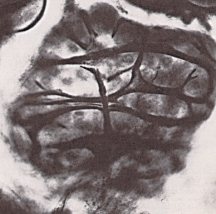
- Stimulation of uterine smooth muscle (myometrium) contraction at birth
During labour, cortisol, a steroid hormone, is produced by the fetus and passed into the placenta, stimulating the secretion of oestrogen and prostaglandins F2α in the placenta and inhibiting the secretion of progesterone. This leads to an increase in sensitivity of the myometrium to oxytocin, causing further contractions of the myometrium. This is in conjunction with the fact that there is an increase in oxytocin receptors in the myometrium. When the fetus stimulates the cervix and vagina, the pressure stimulates the secretion of more oxytocin which enhances contractions in order to facilitate birth. In the first few weeks following the birth, the release of oxytocin during breastfeeding can cause painful contractions of the uterine muscle.
- Secretion into the blood at orgasm
Both males and females secrete oxytocin. In males, oxytocin is synthesised in the hypothalamus and the testes and is detected during ejaculation. It facilitates sperm transport and also affects some aspects of male sexual behaviour.
- Reduce the secretion of urine slightly
Due to its similarity to the antideuretic hormone vasopressin. A high dose of oxytocin can lead to hyponatremia, a deficiency of sodium in the blood as it can stimulate sodium excretion from the kidneys.
Actions in the Brain
Oxytocin released from the pituitary gland cannot re-enter the brain due to a blood-brain barrier. Oxytocin has a role in social behaviour in many species. The behavioural effects of oxytocin reflect the release of oxytocin from the neurons which project into the brain and spinal cord, where oxytocin receptors are present. Oxytocin released in the brain causes:
- Sexual arousal
- Bonding – concentrations of oxytocin in blood was found to be higher in people who were falling in love. A lack of oxytocin pathways in the brain is suggested to be a feature of autism.
- Establishment of maternal behaviour – during birth, an increase in the concentration of oxytocin in the cerebrospinal fluid plays a major role in ensuring that mothers become attached to their offspring and nourish them after birth. Evidence for this was obtained from experiments on other animals.
- Anti-stress functions – oxytocin reduces blood pressure and cortisol levels which reduces anxiety and fear (by inhibiting amygdala) and increases tolerance to pain. It also reduces withdrawal symptoms.
- Trust – an increase in oxytocin levels led to people displaying a higher level of trust.
Uses of Oxytocin
Synthetic oxytocin is sold as a medication and can be administered by injection or as a nasal spray. The latter has better access to the brain and spinal cord and is used to stimulate breastfeeding. Synthetic oxytocin is widely used clinically to help induce and support labour and to control bleeding after delivery. In case of non-progression during birth, due to non-sufficient uterine contractions, oxytocin infused in large amounts causes further contractions of the myometrium. This must be done with care to ensure the safety of the fetus. The nasal spray can also be used to treat those suffering from social anxieties due to the trust-inducing property in oxytocin.
References
http://en.wikipedia.org/wiki/Oxytocin
http://www.vivo.colostate.edu/hbooks/pathphys/endocrine/hypopit/oxytocin.html
ColoState.edu - (from on-line textbook, Pathophysiology of the Endocrine System), R.A. Bowen
http://www.britannica.com/nobel/micro/445_91.html
http://www.rcsb.org/pdb/explore.do?structureId=1NPO
http://www.chm.bris.ac.uk/org/RJCox/4.1_Oxytocin.html
http://mammary.nih.gov/reviews/lactation/Neville002/index.html


